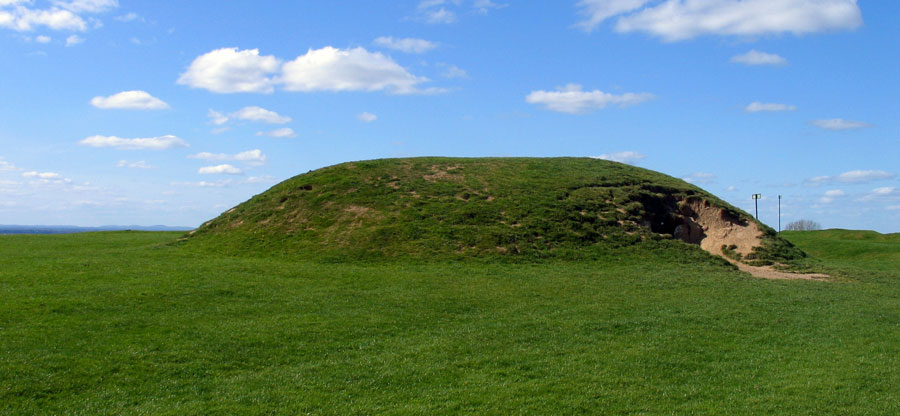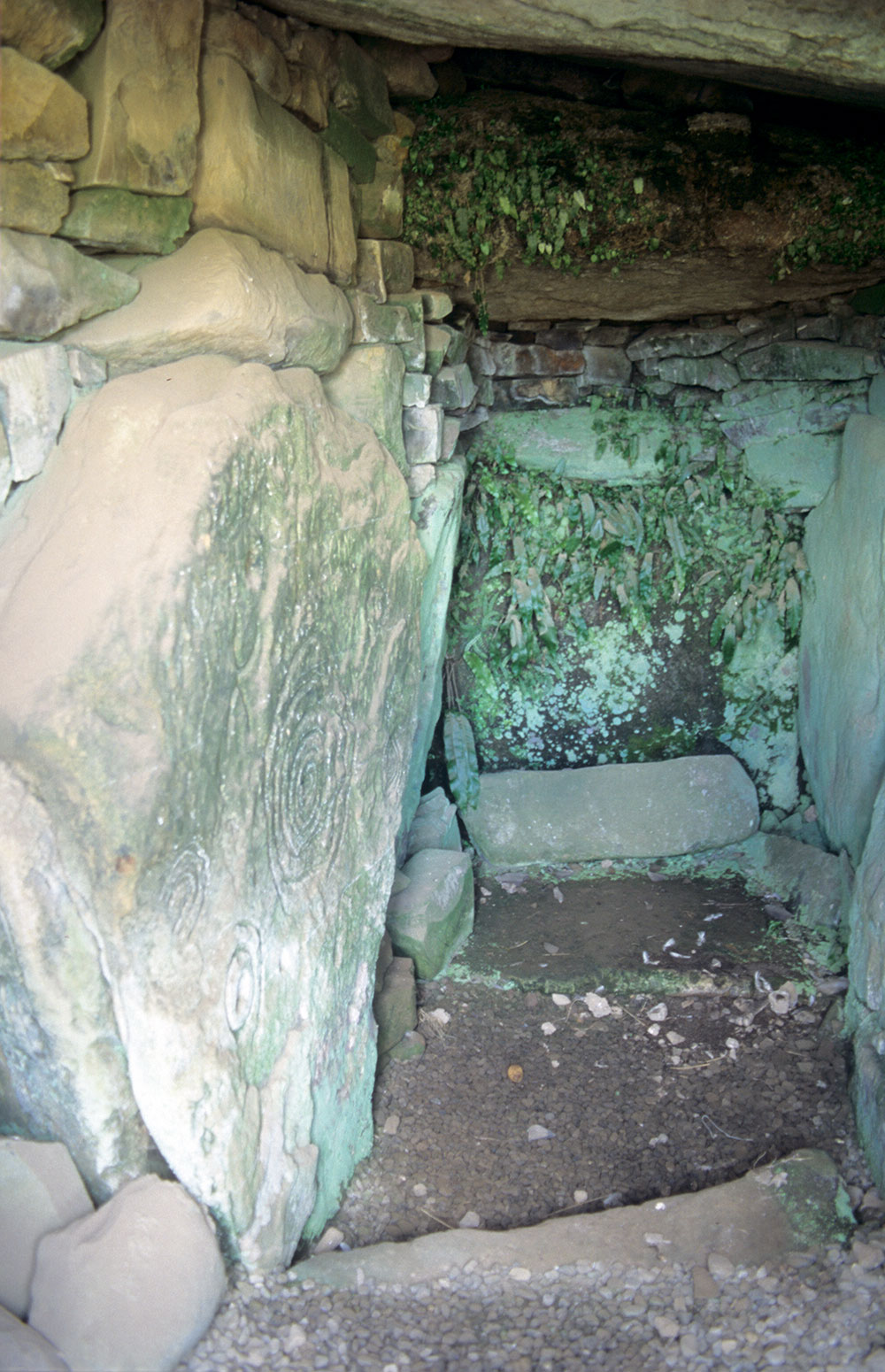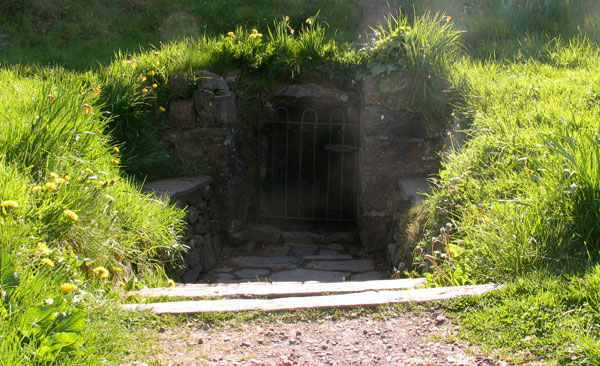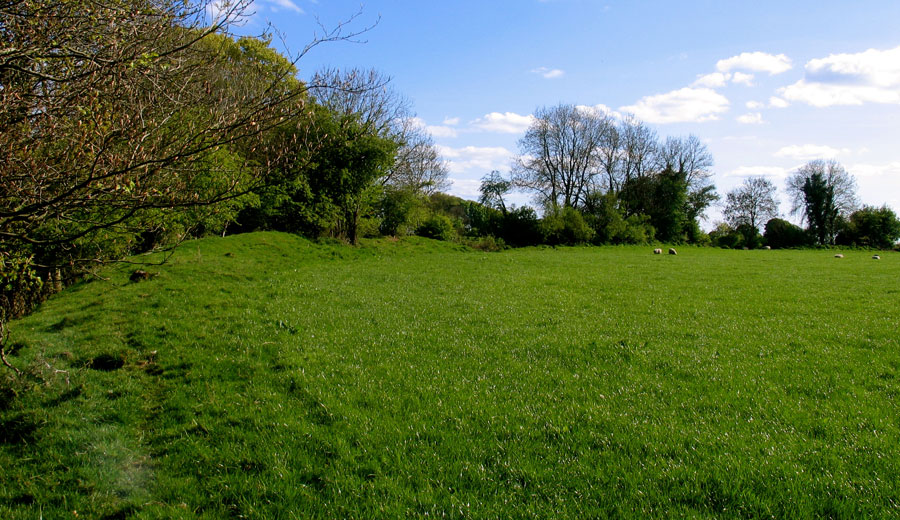Rehineler, bir neolitik odacıklı höyüğün Höyük Tara büyük multi-süresi yerinde eski görünür eserlerinden biridir. Loughcrew Hills, benzer neolitik höyükleri büyük bir grup kuzeybatısında 40 km, fotoğrafın sol görülebilir.
Tara Tepesi İrlanda'nın en ünlü ve efsanevi antik kentlerinden biridir. Bu düşük ve particuarly heybetli değil tepenin 155 metre yükselir, ama Meath Plains genelinde ve çok İrlanda merkezinde görkemli bir görünüm sunuyor. Erken Neolitik erken Hıristiyanlık dönemine kadar uzanan tepenin yayılmış birçok antik anıtlar bulunmaktadır. Tara muhtemelen en iyi İrlanda Yüksek Krallar koltuğu olarak bilinir, ve sık sık çeşitli mitolojik metinlerde geçmektedir.
Kalır bu en üst ya da güney ucunda duran ve akılda çeşitli nesir ve İrlandalı annalists arasında ozanlarla geçmişleri taşıyan, biri kendi dünyevi işgalcilere ile peopling, hayal, yine antik kahramanlık kere dönülüyor yardım ve olamaz. İşte başlarını üzerine altın kronlar ile kralların gün oturdu; şairleri ve arp ile minstrals;; gri sakallı ollamhs; ellerinde yüzsüz kılıç savaşçı kendi meşe yapraklı taç druidler .....
William Wilde
Tara ana anıtlar 2 km uzunluğunda tepeye yayılmış Raths, ringforts ve muhafazaları, oluşur. İrlanda en diğer antik siteleri gibi, Neolitik insanlar ilk buraya geldi. Tara eski yapı Rehinlerin Höyük olarak bilinen tepenin zirvesinde küçük odacıklı cairn olduğunu. Bu höyük, yaklaşık 3000 M.Ö. kalma, Rath na Rig, Kings Fort olarak bilinen büyük bir muhafazanın kuzey kenarında içinde sadece yatıyor. Bu büyük kutu içinde cojoined ringforts bir çift, Forrad ve Cormaic öğretin, ve Forrad içindeki Destiny ünlü Lia Fail ya Stone.
Rehine Höyük iç.
Rehine Höyük hemen kuzeyinde, modern kilise gerekçesiyle tarafından bölünür sinodlar, en Rath ve eskitme kalıntıları vardır. Kuzeyinde tekrar uzun, doğrusal hafriyat sadece, muhtemelen bir Cursus kalıntıları, ya da tören yoludur Midchuarta, sözde Banqueting Hall, öğretin. Salonun Batı Rath Grainne ve Cloenfherta, Eğik Açmalar olduğunu. Rath na Rig güneyinde Rath Loegaire ve daha güneyde Tara sırtın diğer ucunda yaklaşık 1 km Rath Maeve, büyük bir muhafaza olduğunu.
Tara Tepesi doğu tarafında da Healer olarak bilinen Karanlık Göz Eh,.
Buna ek olarak Tara birkaç kuyu vardır. Yerel irfan tepede yedi kuyu vardı diyor; bazı Rath na Rig hemen doğusunda yer alır ve bir çok isimleri vardır yıkılmış ve kuyuların bilinen iyi doldurulmuş edilmiştir: Koyu Göz Eh, Eh Beyaz İnek, physican ve Şifa. Su lezzetli ve bazı isimlerin öne sürdüğü gibi, bu iyileştirici güçleri olduğu söyleniyor. Mezarlıkta iki ayağı taş, biri uzun boylu ve ince bir Tara krallığı ritüelin parçası olduğu söyleniyor ki, kısa ve bodur. Uzun taş Sheela-na-Gig bir oyma var.

[FONT=Verdana, Arial, Helvetica, sans-serif][SIZE=-1]The Mound of the Hostages, a neolithic chambered mound, is one of the oldest visible monuments at the great multi-period site of Tara. The Loughcrew Hills, a large group of similar neolithic mounds 40 km to the northwest, can be seen to the left of the photo.
[FONT=Verdana, Arial, Helvetica, sans-serif][SIZE=-1]The Hill of Tara is one of Ireland's most famous and mythical ancient sites. This low and not particuarly imposing hill rises to 155 meters, but offers a majestic view across the Plains of Meath and much of the centre of Ireland. There are many ancient monuments spread across the hilltop ranging from the early neolithic to early Christian times. Tara is probably best known as the seat of the High Kings of Ireland, and is frequently mentioned in various mythological texts.[/SIZE][/FONT]


 [/SIZE][/FONT]
[/SIZE][/FONT]
Tara Tepesi İrlanda'nın en ünlü ve efsanevi antik kentlerinden biridir. Bu düşük ve particuarly heybetli değil tepenin 155 metre yükselir, ama Meath Plains genelinde ve çok İrlanda merkezinde görkemli bir görünüm sunuyor. Erken Neolitik erken Hıristiyanlık dönemine kadar uzanan tepenin yayılmış birçok antik anıtlar bulunmaktadır. Tara muhtemelen en iyi İrlanda Yüksek Krallar koltuğu olarak bilinir, ve sık sık çeşitli mitolojik metinlerde geçmektedir.
Kalır bu en üst ya da güney ucunda duran ve akılda çeşitli nesir ve İrlandalı annalists arasında ozanlarla geçmişleri taşıyan, biri kendi dünyevi işgalcilere ile peopling, hayal, yine antik kahramanlık kere dönülüyor yardım ve olamaz. İşte başlarını üzerine altın kronlar ile kralların gün oturdu; şairleri ve arp ile minstrals;; gri sakallı ollamhs; ellerinde yüzsüz kılıç savaşçı kendi meşe yapraklı taç druidler .....
William Wilde
Tara ana anıtlar 2 km uzunluğunda tepeye yayılmış Raths, ringforts ve muhafazaları, oluşur. İrlanda en diğer antik siteleri gibi, Neolitik insanlar ilk buraya geldi. Tara eski yapı Rehinlerin Höyük olarak bilinen tepenin zirvesinde küçük odacıklı cairn olduğunu. Bu höyük, yaklaşık 3000 M.Ö. kalma, Rath na Rig, Kings Fort olarak bilinen büyük bir muhafazanın kuzey kenarında içinde sadece yatıyor. Bu büyük kutu içinde cojoined ringforts bir çift, Forrad ve Cormaic öğretin, ve Forrad içindeki Destiny ünlü Lia Fail ya Stone.
Rehine Höyük iç.
Rehine Höyük hemen kuzeyinde, modern kilise gerekçesiyle tarafından bölünür sinodlar, en Rath ve eskitme kalıntıları vardır. Kuzeyinde tekrar uzun, doğrusal hafriyat sadece, muhtemelen bir Cursus kalıntıları, ya da tören yoludur Midchuarta, sözde Banqueting Hall, öğretin. Salonun Batı Rath Grainne ve Cloenfherta, Eğik Açmalar olduğunu. Rath na Rig güneyinde Rath Loegaire ve daha güneyde Tara sırtın diğer ucunda yaklaşık 1 km Rath Maeve, büyük bir muhafaza olduğunu.
Tara Tepesi doğu tarafında da Healer olarak bilinen Karanlık Göz Eh,.
Buna ek olarak Tara birkaç kuyu vardır. Yerel irfan tepede yedi kuyu vardı diyor; bazı Rath na Rig hemen doğusunda yer alır ve bir çok isimleri vardır yıkılmış ve kuyuların bilinen iyi doldurulmuş edilmiştir: Koyu Göz Eh, Eh Beyaz İnek, physican ve Şifa. Su lezzetli ve bazı isimlerin öne sürdüğü gibi, bu iyileştirici güçleri olduğu söyleniyor. Mezarlıkta iki ayağı taş, biri uzun boylu ve ince bir Tara krallığı ritüelin parçası olduğu söyleniyor ki, kısa ve bodur. Uzun taş Sheela-na-Gig bir oyma var.

[FONT=Verdana, Arial, Helvetica, sans-serif][SIZE=-1]The Mound of the Hostages, a neolithic chambered mound, is one of the oldest visible monuments at the great multi-period site of Tara. The Loughcrew Hills, a large group of similar neolithic mounds 40 km to the northwest, can be seen to the left of the photo.
[FONT=Verdana, Arial, Helvetica, sans-serif][SIZE=-1]The Hill of Tara is one of Ireland's most famous and mythical ancient sites. This low and not particuarly imposing hill rises to 155 meters, but offers a majestic view across the Plains of Meath and much of the centre of Ireland. There are many ancient monuments spread across the hilltop ranging from the early neolithic to early Christian times. Tara is probably best known as the seat of the High Kings of Ireland, and is frequently mentioned in various mythological texts.[/SIZE][/FONT]
[FONT=Verdana, Arial, Helvetica, sans-serif][SIZE=-1]Standing at the top or southern extremity of this remain, and bearing in mind the various prose and bardic histories of the Irish annalists, one cannot help reverting to ancient heroic times, and again, in imagination, peopling it with its earthly occupants. Here sat in days of your kings with golden crowns upon their heads; warriors with brazen swords in their hands; bards and minstrals with their harps; grey-bearded ollamhs; druids with their oak-leaf crowns.....[/SIZE][/FONT]
[FONT=Verdana, Arial, Helvetica, sans-serif][SIZE=-1]William Wilde [/SIZE][/FONT]
[FONT=Verdana, Arial, Helvetica, sans-serif][SIZE=-1]The main monuments at Tara consist of raths, ringforts and enclosures, which are spread across the 2 km long hill. Like most other ancient sites in Ireland, the neolithic people arrived here first. The oldest building at Tara is a small chambered cairn on the summit of the hill which is known as the Mound of the Hostages. This mound, dating to about 3000 BC, lies just within the northern edge of a massive enclosure known as Rath na Rig, The Fort of the Kings. Within this great enclosure are a pair of cojoined ringforts, the Forrad and Teach Cormaic, and within the Forrad is the famous Lia Fail or Stone of Destiny.[/SIZE][/FONT]
[FONT=Verdana, Arial, Helvetica, sans-serif][SIZE=-1]The interior of the Mound of Hostages.[/SIZE][/FONT]
[FONT=Verdana, Arial, Helvetica, sans-serif][SIZE=-1]Just north of the Mound of the Hostages are the tumbled remains of the Rath of the Synods, which is cut into by the grounds of the modern church. Just north again is a long, linear earthwork, Teach Midchuarta, the so called Banqueting Hall, which is probably the remains of a cursus, or ceremonial pathway. West of the hall is Rath Grainne and the Cloenfherta, the Sloping Trenches. To the south of Rath na Rig is Rath Loegaire, and about 1 km further south on the other end of Tara ridge is Rath Maeve, a massive enclosure.[/SIZE][/FONT]
[FONT=Verdana, Arial, Helvetica, sans-serif][SIZE=-1]The Well of the Dark Eye, also known as The Healer, on the east side of the Hill of Tara.[/SIZE][/FONT]
[FONT=Verdana, Arial, Helvetica, sans-serif][SIZE=-1]In addition there are several wells at Tara. Local lore says there were seven wells on the hill; some have been destroyed and filled in. The best known of the wells lies just east of Rath na Rig and has many names: The Well of the Dark Eye, Well of the White Cow, the Physican and the Healer. The water is delicious and as some of the names suggest, it is said to have healing powers. In the graveyard are two pillar stones, one tall and thin, one short and stumpy, which are said to be part of the kingship ritual at Tara. The taller stone has a carving of a Sheela-na-Gig.[/SIZE][/FONT]
